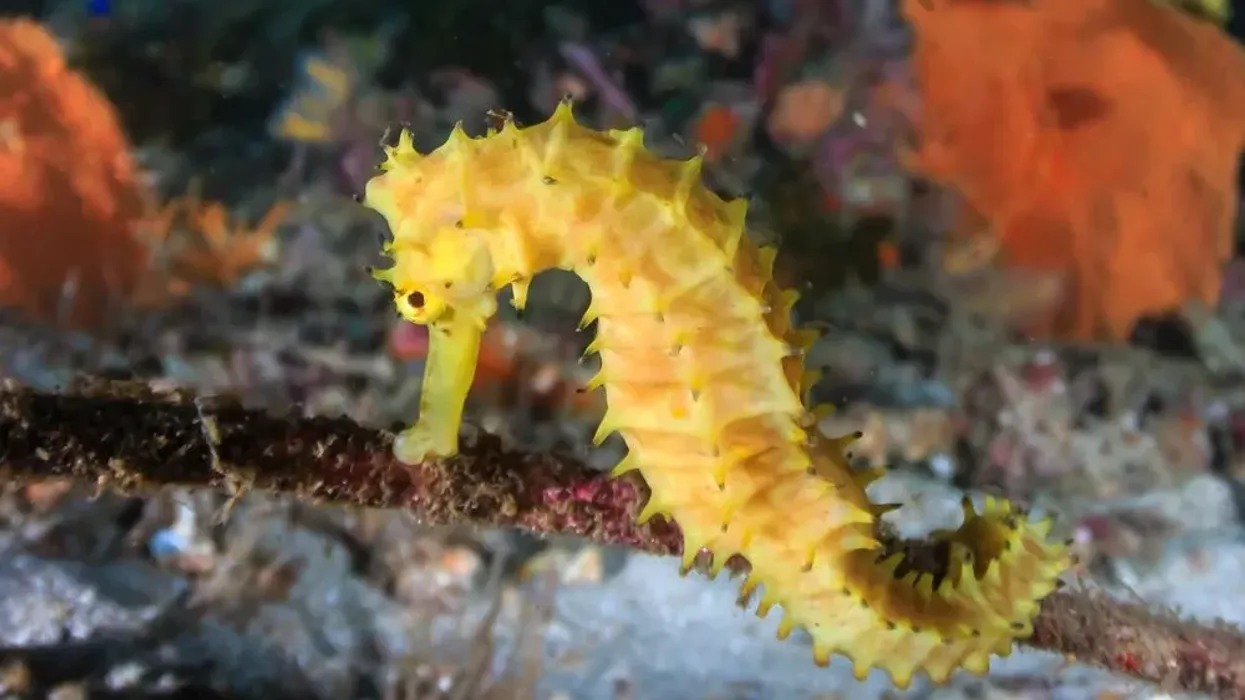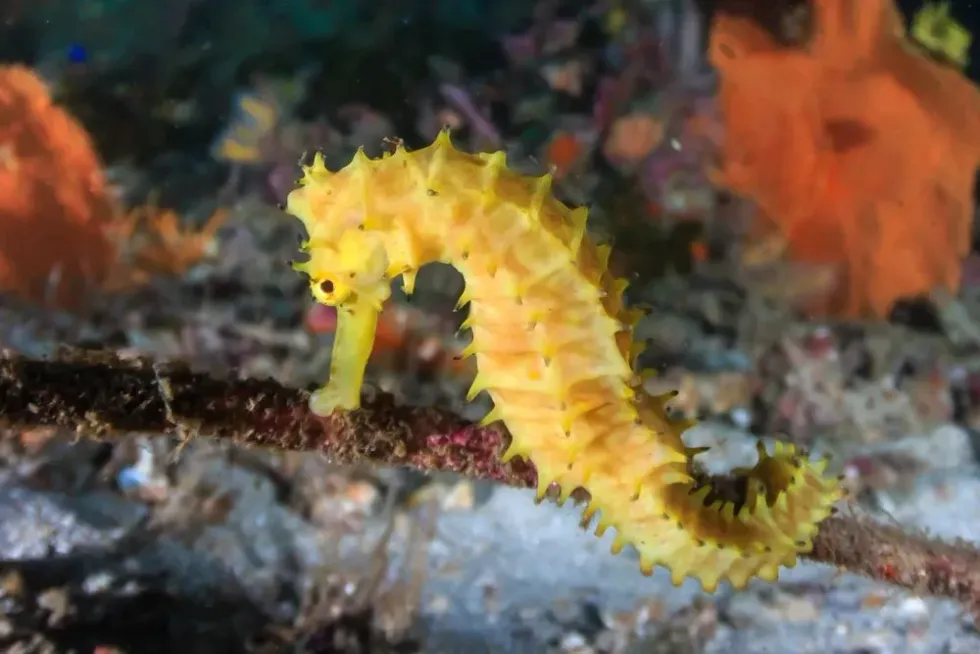Ever wondered which male species can give birth to young? Do you think romance exists within the animal kingdom? Can marine animals be awful swimmers? Yes, yes, yes is the answer to all of the questions!
Tiger tail seahorses are among the most unique and attractive aquatic wildlife species on the planet. However, these mysterious sea creatures have a few gimmicks up their sleeves. India, Malaysia, Indonesia, the Philippines, Singapore, Thailand, and Vietnam are all home to this species.
Seahorse couples welcome each other every morning with ritualistic dances proving that humans are not alone who date. Although small in size, they can be called as assassins of the sea.
They have a good predatory kill rate of 90%, thanks to their stealthy hunting technique. Sea horses are endangered as significant amounts of seahorses are also gathered for Chinese herbal medicine and aquarium trade. The Knysna seahorse (Hippocampus capensis) is the world's rarest seahorse, and the Hippocampus kuda being the most common sea horse.
Scroll down through the incredible facts that can forever change your perspective on seahorses. You may also go through our other articles on bonito fish facts and rockfish facts.
Tiger Tail Seahorse Interesting Facts
What type of animal is a tiger tail seahorse?
Hippocampus comes (tiger tail seahorse) comes from the family of family Syngnathidae is a fish species.
What class of animal does a tiger tail Seahorse belong to?
The tiger tail seahorse (Hippocampus comes) belongs to the class of Actinopterygii.
How many tiger tail Seahorses are there in the world?
There is no specific data on the exact number of tiger tail sea horses globally. As per few studies previously, some Islands of the Philippines had 20 tiger-tail seahorses per square meter, but this is no longer the case, as their population has been declining.
Tropical fish intended for aquariums are often caught using cyanide fishing, which is harmful to the environment. In addition, traditional Chinese medicine uses the seahorse, which has been a significant threat to this species.
Where does a tiger tail seahorse live?
Are you thinking of where to find this seahorse species? The tiger tail seahorse is a species of seahorse that can be found in the Western Central Pacific.
India, Indonesia, Singapore islands, the Philippines, Thailand, Malaysia, and Vietnam are the places you can see a tiger tail seahorse. They also are perfect for an aquarium and can be grown through aquaculture.
What is a tiger tail seahorse's habitat?
Coral reefs, sponge beds, and seagrasses at a depth of 32.8-65.6 ft (10-20 m) are natural habitats for this species. Tiger tail seahorses thrive in a slightly warmer temperature level than other seahorses.
Tiger-tail adults and juveniles live in various habitats, which is a common survival strategy in the animal kingdom. Climate and change in the environment are threatening the habitat of these corals.
Who does a tiger tail Seahorse live with?
Seahorses are social animals, and they move in pairs or a group along tropical waters in the Indo-Pacific around Malaysia, Vietnam, Singapore, and as far east as the Philippines. A group of seahorses is referred to as a herd.
We've often seen them congregating in one place; they are highly social seahorses. However, did you know that the adult seahorses and the juveniles do not stay together and share a different habitat?
How long does a tiger tail seahorse live?
Tiger tail seahorses live for 0-1.5 years in captivity, and in the wild, it lives for 1-5 years. Tiger tail seahorses will live for four to seven years with proper setup and treatment.
Cyanide fishing is also one reason to shorten the lifespan of wild fish. The cyanide solution is used to shock fish, allowing them to be quickly captured alive and thus shortening their lives.
How do they reproduce?
Seahorses with tiger tails are monogamous! In the world of seahorses, romance exists! When ready to mate, the male performs a dance, then changes color, performs blatant pouch displays and active gyrations in front of the female.
Until mating, their courtship dance will last up to a week. If the female is interested, she will entwine tails with the male, dance, and place eggs in the male pouch. The male accepts eggs from one female only.
The female will deposit up to 2,000 eggs in the male's brood pouch to be fertilized. For one to four weeks, the male protects and feeds the young in his pouch. H. comes frequently spawn, with brood size ranging from 195 to 626 eggs (average 360 eggs).
What is their conservation status?
Hippocampus comes is threatened across their range due to their popularity in traditional medicine and the aquarium trade. As a result, the conservation status is listed as Vulnerable on the IUCN Red List.
Coral reefs have been bleaching due to climate change, and dynamite fishing is a common cause of habitat damage. Project Seahorse is a marine conservation group that focuses on seahorses and their habitat.
Tiger Tail Seahorse Fun Facts
What do tiger tail Seahorses look like?
A tropical seahorse has striking yellow and black rings running down its back. Tiger tail seahorses grow up to 6 in (15.24 cm) long and can be found on soft coral reefs worldwide, from India, Indonesia to the Philippines.
Tiger tail seahorses have long snouts, prehensile tails, and 16–19 pectoral fins and are black and yellow in color. The body of the tiger tail seahorse is spiny (with blunt spines), and it has a high nose spine, and double cheek spines.
Its stripped tail also helps to distinguish it from other seahorses. This specimen species has a moderate dorsal, with two trunk rings and one tail ring.
How cute are they?
The look of this fish is unique, with a striped curly tail, dorsal fin, and yellow and black rings. The male and female graceful courtship dance is a watch for the eye.
Do not judge these fish only by look; they are known to be disguise masters, and they are highly predatory species in the waters of India to the Philippines.
How do they communicate?
According to a new study, when seahorses are stressed, they growl. When they're courting each other, they even click.
How big is a tiger tail seahorse?
Tiger tail seahorses grow up to 6 in (15.24 cm) long and can be found on soft coral reefs all over the world, from India to the Philippines. The maximum size H. comes is believed to grow around 7.5 in (18.7 cm).
It's a tiny seahorse compared to Hippocampus abdominalis, or the big-bellied seahorse, which can grow to be over 14 in (35 cm).
How fast can a tiger tail seahorse move?
Although a marine species, seahorses are shockingly awful swimmers. Because of the tiny fin in the center of their back, they are the slowest of all species.
However, do not decide the swimming capability only by its speed! On the other hand, seahorses are unusual in that they can go forward and up, down, and backward, with a dorsal fin.
How much does a tiger tail seahorse weigh?
These tiger tails sea horses are very small in size, and their exact weight is unavailable. However, seahorse usually weighs from 7-1 oz (198.4-28.3 gm).
What are the male and female names of the species?
There is no specific name given to male and female seahorses. A male is called a male tiger tail seahorse, and a female is called a female tiger tail seahorse.
What would you call a baby tiger tail seahorse?
The baby of the seahorse is called as a fry. The fry feed on the zooplankton. However, the juveniles are left to live by themselves after birth.
What do they eat?
The tiger tail seahorse is a complete carnivore in the wild, feeding on amphipods and other small crustaceans found in live rock. Small fish, coral, small shrimp, and plankton are a few food sources.
In aquariums or aquaculture farming, seahorses are fed live or vitamin-enriched frozen or freeze-dried Mysis Shrimp if they eat it. Seahorses should be fed regularly, with each feeding lasting 20-30 minutes. Zooplankton is the feed for juveniles.
Are they poisonous?
No data is found on how poisonous seahorses are. However, they are one of the deadliest creatures under the sea. When seahorse get close enough to food, it can easily jerk its head back and eat the tiny copepod. This method works 90% of the time, making the seahorse one of the deadliest creatures on the planet.
Would they make a good pet?
If you are looking for a different species with lots of interesting personalities as a pet in your aquarium, the tiger tail seahorse (Hippocampus comes) may be the right choice. It can also be grown through aquaculture.
This species grows to be 5-7 in (12.7-17.8 cm) long in captivity. Tiger tail seahorses sometimes develop a favorite hitching area in the aquarium, and they would choose to spend the majority of their time there. With their favorite spots, they are a more clingy species.
Since seahorses are very social animals, we do not suggest having them alone; you should have at least two or more individuals. Pipefish and Mandarinfish are good tankmates.
However, never assume that growing them in captivity is easy. Proper care and observation are a must when raised through aquaculture or in an aquarium.
Since seahorses are fish, they are susceptible to all or almost all of the diseases that affect other fish. The majority of seahorse diseases are caused by poor aquarium water quality. External and internal gas bubble disease, flesh-erosion disease, snout rot, exophthalmia, ectoparasites, and endoparasites are a few diseases the tiger tail sea horse (Hippocampus comes) faces.
Did you know...
They are one of the most widely fished seahorse species in the wild and one of the most prolific in captivity. Hippocampus comes has a high fertility and survival rate compared to other Hippocampus genus members that have been reared in aquaculture and aquarium trade. Perhaps there would be less dissent if they can be raised in captivity instead.
Although this seahorse species is highly predatory, the seahorse is preyed upon by various predators in its natural habitat because of its small size and vulnerability. The seahorse is preyed upon by a variety of crustaceans, including crabs, fish, and rays.
How did tiger tail Seahorses get their name?
Are you wondering how this seahorse species got its name as tiger tail? Let us tell you, the name of this specimen species is derived from the identifiable unique tail band markings on this sea horse, and thus named as tiger tail sea horse.
Seahorse species belong to the genus Hippocampus, which comes from the ancient Greek Hippokampos, which means hippo for horse and kampos for a sea monster. Hippocampus comes was first mentioned in the mid-nineteenth century.
How many different types of seahorses exist?
As per a study, there are 47 separate species of seahorses, with 14 of them being discovered in the last eight years (as per 2010), including the Pontoh's pygmy seahorse (Hippocampus pontohi), which was named in 2008.
A spiny body (with blunt spines), a high nose spine, and double cheek spines can act as an identification guide to identify the tiger tail seahorse.
It can also be distinguished from other seahorses by its striped tail.
Here at Kidadl, we have carefully created lots of interesting family-friendly animal facts for everyone to discover! For more relatable content, check out these tang fish facts and rainbow trout facts pages.
You can even occupy yourself at home by coloring in one of our free printable tiger tail seahorse coloring pages.









